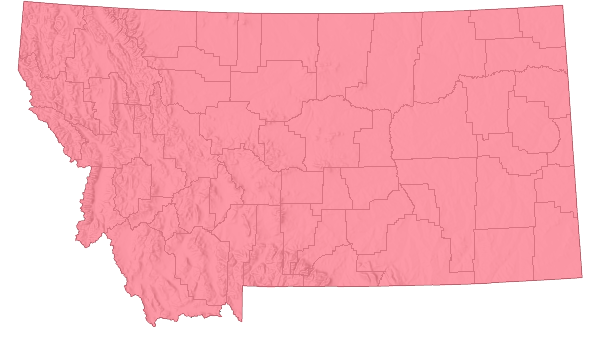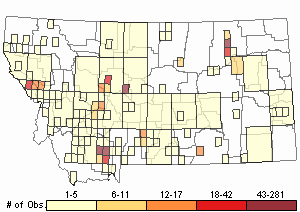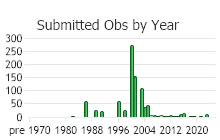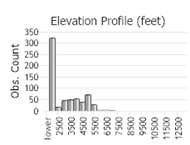View in other NatureServe Network Field Guides
NatureServe
Montana
Utah
Wyoming
Idaho
Wisconsin
British Columbia
South Carolina
Yukon
California
New York
Diffuse Knapweed - Centaurea diffusa
Other Names:
Bushy Star-thistle, White Knapweed, Tumble Knapweed,
Acosta diffusa
State Rank Reason (see State Rank above)
Centaurea diffusa is a plant native to Eurasia and introduced worldwide (FNA 2006). A conservation status rank is not applicable (SNA) because the plant is an exotic (non-native) in Montana that is not a suitable target for conservation activities.
General Description
PLANTS: Taprooted, annuals or rarely short-lived perennials that grow in terrestrial habitats (Parkinson et al. 2011; Lesica et al. 2012). Stems are erect, branched, and grow about 20-100 cm tall (FNA 2006; Lesica et al. 2012). Plants are sparsely gray tomentose and resin-gland-dotted.
LEAVES: Leaves of the rosette (basal) and lower stem are long-petiolate, and often shrivel by maturity (FNA 2006; Lesica et al. 2012). Leaf blades are ovate, 3–12(20) cm long, and deeply pinnate (1 to 2 times divided) into linear-oblanceolate lobes. Leaves become sessile, smaller, and less dissected upwards.
INFLORESCENCE: Paniculate with several heads of whitish (sometimes purplish) flowers that occur on the ends of leafy branches (Lesica 2012; Sheley and Petroff 2009). Involucres are ovoid and 8–13 mm high. Involucral bracts (phyllaries) are pale green, ovate to lanceolate, and glabrous or finely tomentose. The margins of the bracts (appendages) are fringed with spines and end with a long, spreading spine of 1-5mm long (FNA 2006; Sheley and Petroff 2009).
Phenology
Flowering June to September, sometimes October.
Diagnostic Characteristics
The Montana Natural Heritage Botany Programs follows the
Centaurea treatment by Keil and Ochsmann in FNA Volume 19 (2006). The
Manual of Montana Vascular Plants (Lesica et al. 2012) treats this plant as
Centaurea maculosa Lam.
For over 200 years there has been a lot of confusion in the European literature regarding the nomenclature used for
Centaurea stoebe (FNA 2006). The names used in this group (
C. stoebe, C. rhenana, C. maculosa, C. biebersteinii) have been applied to different taxa by different authors using different concepts. This was apparent between western and eastern Europe and was not taken into consideration in the treatment by J. Dostal (1976) (FNA 2006).
Recent studies have shown that the American plants are a tetraploid perennial that is very distinct from the diploid, biennial plants native to central Europe (FNA 2006).
Centaurea stoebe ssp.
micranthos being in America while plants in central Europe are known by the names of
C. stoebe Linnaeus ssp.
stoebe,
C. rhenana Boreau, or
C. maculosa Lamarck. In most American literature the name
Centaurea maculosa Lamarck was misapplied to
C. stoebe spp.
micranthos. Others, such as W.A. Weber (1987, 1990) accepted the name of
Acosta maculosa based on a treatment of about 100 plants in the
Centaurea sect.
Acrolophus Cassini (J. Holub et al. 1972). However, the genus
Acosta is not supported by morphologic and molecular characteristics and is not widely accepted in Europe (FNA 2006).
Spotted Knapweed (Centaurea stoebe ssp. micranthos) has unique involucral bracts that have a dark colored tip and fringe that appear as “spots” from a distance.
Diffuse Knapweed (Centaurea diffusa) also grows a single, branched stem from a similar looking rosette. However, its growth develops a ball-shaped appearance and a tumbleweed mobility (Parkinson et al. 2011). Flowers are usually white or occasionally light purple. The flower bracts may have dark-colored tips but lack the dark fringe found in Spotted Knapweed. Bracts possess a rigid terminal spine (1/4 to 1/3 of an inch long) with 4-5 pairs of shorter, lateral spines (Parkinson et al. 2011).
Centaurea stoebe ssp.
micranthos readily hybridizes with
Centaurea diffusa (FNA 2006; Parkinson et al. 2011). These fertile hybrids have been named
Centaurea x
psammogena G. Gayer. Characteristics of the hybrids are variable, except for the cypselae (fruit) which always bears a pappus and the flower heads are always conspicuously radiant (composed of ray florets). Hybrids are often mis-identified as diffuse knapweed and may occur where their parent’s ranges overlap or are separate.
Species Range
Montana Range
Range Descriptions

 Non-native
Non-native
Range Comments
Centaurea diffusa is native to southeastern Europe and can be adventive in central and western Europe (FNA 2006). It was first recorded in western North America in 1907 from an alfalfa field in Bingen, Washington (Sheley and Petroff 1999). It has been speculated to come from Turkestan alfalfa seed from the Caspian Sea region and/or hybrid alfalfa seed from Germany (Sheley and Petroff 1999). During the decade of the 1930’s it rapidly moved in the Pacific Northwest and British Columbia (Sheley and Petroff 1999), and by the late 1990’s has colonized all or portions of the western U.S. states (Sheley and Petroff 1999).
For maps and other distributional information on non-native species see:
Nonindigenous Aquatic Species Database from the U.S. Geological Survey
Invasive Species Habitat Tool (INHABIT) from the U.S. Geological Survey
Invasive Species Compendium from the Centre for Agriculture and Bioscience International (CABI)
EDDMapS Species Information EDDMapS Species Information
Observations in Montana Natural Heritage Program Database
Number of Observations: 964
(Click on the following maps and charts to see full sized version)
Map Help and Descriptions
Relative Density

Recency



 (Observations spanning multiple months or years are excluded from time charts)
(Observations spanning multiple months or years are excluded from time charts)
Habitat
Grasslands, roadsides, meadows, open forest, woodlands; plains, valleys, montane (Lesica et al. 2012).
Ecology
Based on information from other western states, diffuse knapweed is most competitive in the shrub steppe zone, particularly the
Purshia tridentata (bitterbrush) habitat types,
Purshia tridentata /
Agropyron spicatum with or without
Stipa comata that are found on light, well-drained soils,
Purshia tridentata with or without
Pinus ponderosa, or
Pinus ponderosa /
Pseudotsuga menziesii /
Symphoricarpos albus or
Physocarpus malvaceus habitat types (Sheley and Petroff 1999). The interior natural grasslands in British Columbia and the short-grass steppe, adjacent montane zone, and lower elevations of the pinyon-juniper-oak brush zones in Colorado are considered vulnerable to invasion by diffuse knapweed (Sheley and Petroff 1999). In Montana large infestations have been found in natural grasslands and forest fringe areas near Helena, Big Timber, and Ennis (Sheley and Petroff 1999).
Soil disturbance increases the rate and density at which diffuse knapweed establishes and allows it to occupy a variety of habitats (Sheley and Petroff 1999). Soil disturbance could be caused from natural (rodent activity or a hail storm) or manmade activities. Diffuse knapweed is a strong competitor and colonizes niches created by disturbance or that are unoccupied (Fletcher and Renny 1963).
The allelopathic properties of diffuse knapweed have been studied over many years (Sheley and Petroff 1999). Cnicin is an allelopathic compound that has been isolated from the leaves and shoots of diffuse knapweed, but when applied in field tests no reduction in grass growth was found (Fletcher and Renny 1963; Kelsey and Bedunah 1989).
In mixed stands with
Centaurea stoebe the hybrid,
Centaurea x
psammogena G. Gayer, replaces
Centaurea diffusa (FNA 2006).
POLLINATORS The following animal species have been reported as pollinators of this plant species or its genus where their geographic ranges overlap:
Bombus vagans,
Bombus bifarius,
Bombus centralis,
Bombus fervidus,
Bombus rufocinctus,
Bombus ternarius,
Bombus terricola,
Bombus occidentalis,
Bombus griseocollis,
Bombus impatiens,
Bombus insularis, and
Bombus suckleyi (Thorp et al. 1983, Johnson 1986, Colla and Dumesh 2010, Koch et al. 2012, Williams et al. 2014, Tripoldi and Szalanski 2015).
Reproductive Characteristics
FLOWERS [adapted from FNA 2006 and Lesica et al. 2012]
Flower heads consist of disk flowers. Each head is composed of 25-35 disk flowers that are white or sometimes purplish. The outer florets have inconspicuous petals and the inner florets have petals of 12-13 mm long. Fruits (cypselae) are dark brown, about 2-3 mm long. and finely hairy. The pappus is lacking or less than 0.5 mm long.
LIFE CYCLE and DISPERSAL [adapted from Sheley and Petroff 1999]
Seeds germinate in the fall and early spring and become tap-rooted rosettes. Seasonal precipitation is important for seedling survival. Crowded plants often die before flowering or may live for several years as a rosette and then die after developing seeds. A portion of early germinating plants may flower in their first year and die, while other individuals will germinate, flower, and continue to grow into their second year. In northeastern Washington, plants averaged 11,200 to 48,100 seeds per square meter.
Diffuse knapweed plants grow into a ball-shape and have evolved to tumble in the wind. The seeds are held in an urn-shaped head which does not open widely, allowing the seeds to gradually disperse as the plant tumbles across the land. This tactic also works well to cling to vehicles and collect along roads, ditches, and fence lines.
Management
Successful management of diffuse knapweed requires that land-use objectives and a desired plant community be identified (Sheley and Petroff 1999). Once identified then an integrated weed management strategy that promotes a weed-resistant plant community and serves other land-use objectives such as livestock forage, wildlife habitat, or recreation can be developed, making control of diffuse knapweed possible.
BIOCONTOL [Adapted from Sheley and Petroff 1999]
At least 200 insects are recommended for establishing a sustainable population. Infestations should be at least 2 acres with sizeable populations. It may take 2-3 years for the insect population to establish.
In the U.S. 12 flower seedhead and root-boring insect species are known to attach diffuse knapweed.
Knapweed Gall Flies (
Urophora affinis, U. quadrifasciata) were released over 20 years ago in Montana and now are well-established in the western U.S. Flies have been shown to have high occupancy rates in the flower heads, yet a reduction in seed production was not apparent.
Knapweed Seed Head Weevils (
Larinus minutus, L. obtusus) feed on foliage and flowers and are widely distributed and established.
Knapweed Root Boring Weevil (
Cyphocleonus aschates) is well established. Larvae feed on taproots.
Sulphur Knapweed Moth (
Agapeta zoegana) is established in parts of Montana. Larvae of these moths feed on the roots.
Bronze Knapweed Root Borer (
Sphenoptera jugoslavica) is well established in parts of Montana. On hot, dry sites where there is competition with perennial plants, the larvae can weaken diffuse knapweed rosettes. It is presumed to be less damaging on cooler, moister sites because female beetles need five days of higher temperatures to lay eggs and larvae survival improves with dry conditions.
CHEMICAL CONTROL [Adapted from Sheley and Petroff 1999]
Herbicides are effective, especially when properly managed with other tactics. The herbicide type and concentration, timing of chemical control, soil properties, and other factors will determine its effectiveness and impact to non-target species. Strict adherence to application requirements defined on the herbicide label will reduce risks to human and environmental health. Many herbicides must be applied by applicators with an Aquatic Pest Control license. Consult your County Extension Agent and/or Weed District for more information on herbicidal control.
Herbicides are more effective when applied to the rosette stage. Registered herbicides for Diffuse Knapweed include:
Picloram (0.25-0.50 pound per acre),
clopyralid (0.25-0.50 pounds per acre),
Curtail® (2-5 quarts per acre), and
2,4,-D (1-2 pounds per acre).
CULTURAL and GRAZING CONTROLS [Adapted from Sheley and Petroff 1999]
Hand-pulling that extracts the full taproot is effective, particularly when soil is moist. In the rosette stage, taproots that are severed directly below the root crown have a higher rate of re-growth than when severed 2-4 inches below the crown. All plant material should be bagged, desiccated or burned, before placing in the trash for disposal. Gloves should be worn to protect skin.
Mowing is not very effective at reducing seed production. When mowed in the early flowering stage plants often re-grow and produce abundant late-season seeds.
Burning can damage plants, but is not effective at preventing growth, germination, or flowering.
Grazing. Diffuse knapweed is more likely to be grazed: a) by sheep than by cattle, b) when it is green and succulent (stages from rosette to flower bud), especially if adjacent vegetation is curing, and c) when it is the only available plant. Grazing should be timed to minimize damage during critical stages of growth for the desirable vegetation.
Revegetation that establishes a desirable perennial plant community will compete against diffuse knapweed for water, nutrients, and light. Proper revegetation of disturbed sites are necessary to reduce knapweed populations.
Useful Links:Montana Invasive Species websiteMontana Biological Weed Control Coordination ProjectMontana Department of Agriculture - Noxious WeedsMontana Weed Control AssociationMontana Weed Control Association Contacts Webpage.
Montana Fish, Wildlife, and Parks - Noxious WeedsMontana State University Integrated Pest Management ExtensionWeed Publications at Montana State University Extension - MontGuidesStewardship Responsibility
References
- Literature Cited AboveLegend:
 View Online Publication
View Online Publication Colla, S.R. and S. Dumesh. 2010. The bumble bees of southern Ontario: notes on natural history and distribution. Journal of the Entomological Society of Ontario 141:39-68.
Colla, S.R. and S. Dumesh. 2010. The bumble bees of southern Ontario: notes on natural history and distribution. Journal of the Entomological Society of Ontario 141:39-68. Flora of North America Editorial Committee. 2006. Flora of North America North of Mexico. Vol. 19. Magnoliophyta: Asteridae, part 6: Asteraceae, part 1. Oxford Univ. Press, New York. xxiv + 579 pp.
Flora of North America Editorial Committee. 2006. Flora of North America North of Mexico. Vol. 19. Magnoliophyta: Asteridae, part 6: Asteraceae, part 1. Oxford Univ. Press, New York. xxiv + 579 pp. Johnson, R.A. 1986. Intraspecific resource partitioning in the bumble bees Bombus ternarius and B. pennsylvanicus. Ecology 67:133-138.
Johnson, R.A. 1986. Intraspecific resource partitioning in the bumble bees Bombus ternarius and B. pennsylvanicus. Ecology 67:133-138. Koch, J., J. Strange, and P. Williams. 2012. Bumble bees of the western United States. Washington, DC: USDA Forest Service, Pollinator Partnership. 143 p.
Koch, J., J. Strange, and P. Williams. 2012. Bumble bees of the western United States. Washington, DC: USDA Forest Service, Pollinator Partnership. 143 p. Lesica, P., M.T. Lavin, and P.F. Stickney. 2012. Manual of Montana Vascular Plants. Fort Worth, TX: BRIT Press. viii + 771 p.
Lesica, P., M.T. Lavin, and P.F. Stickney. 2012. Manual of Montana Vascular Plants. Fort Worth, TX: BRIT Press. viii + 771 p. Sheley, Roger, and Janet Petroff. 1999. Biology and Management of Noxious Rangeland Weeds. Oregon State University Press, Corvallis, Oregon.
Sheley, Roger, and Janet Petroff. 1999. Biology and Management of Noxious Rangeland Weeds. Oregon State University Press, Corvallis, Oregon. Thorp, R.W., D.S. Horning, and L.L. Dunning. 1983. Bumble bees and cuckoo bumble bees of California (Hymenoptera: Apidae). Bulletin of the California Insect Survey 23:1-79.
Thorp, R.W., D.S. Horning, and L.L. Dunning. 1983. Bumble bees and cuckoo bumble bees of California (Hymenoptera: Apidae). Bulletin of the California Insect Survey 23:1-79. Tripoldi, A.D. and A.L. Szalanski. 2015. The bumble bees (Hymenoptera: Apidae: Bombus) of Arkansas, fifty years later. Journal of Melittology 50: doi: http://dx.doi.org/10.17161/jom.v0i50.4834
Tripoldi, A.D. and A.L. Szalanski. 2015. The bumble bees (Hymenoptera: Apidae: Bombus) of Arkansas, fifty years later. Journal of Melittology 50: doi: http://dx.doi.org/10.17161/jom.v0i50.4834 Williams, P., R. Thorp, L. Richardson, and S. Colla. 2014. Bumble Bees of North America. Princeton, NJ: Princeton University Press. 208 p.
Williams, P., R. Thorp, L. Richardson, and S. Colla. 2014. Bumble Bees of North America. Princeton, NJ: Princeton University Press. 208 p.
- Additional ReferencesLegend:
 View Online Publication
View Online Publication
Do you know of a citation we're missing? Lesica, P., M.T. Lavin, and P.F. Stickney. 2022. Manual of Montana Vascular Plants, Second Edition. Fort Worth, TX: BRIT Press. viii + 779 p.
Lesica, P., M.T. Lavin, and P.F. Stickney. 2022. Manual of Montana Vascular Plants, Second Edition. Fort Worth, TX: BRIT Press. viii + 779 p. Olliff, Tom, Roy Renkin, Craig McClure, Paul Miller, Dave Price, Dan Reinhart, and Jennifer Whipple. 2001. Managing A Complex Exotic Vegetation Program in Yellowstone National Park.
Olliff, Tom, Roy Renkin, Craig McClure, Paul Miller, Dave Price, Dan Reinhart, and Jennifer Whipple. 2001. Managing A Complex Exotic Vegetation Program in Yellowstone National Park. Rens, E.N. 2003. Geographical analysis of the distribution and spread of invasive plants in the Gardiner Basin, MT. M.Sc. Thesis. Bozeman, MT: Montana State University. 100 p.
Rens, E.N. 2003. Geographical analysis of the distribution and spread of invasive plants in the Gardiner Basin, MT. M.Sc. Thesis. Bozeman, MT: Montana State University. 100 p. Story, J.M. 1976. A study of Urophora affinis (Diptera: Tephritidae) released on spotted knapweed in Western Montana. M.Sc. Thesis. Bozeman, MT: Montana State University. 77 p.
Story, J.M. 1976. A study of Urophora affinis (Diptera: Tephritidae) released on spotted knapweed in Western Montana. M.Sc. Thesis. Bozeman, MT: Montana State University. 77 p.
- Web Search Engines for Articles on "Diffuse Knapweed"





